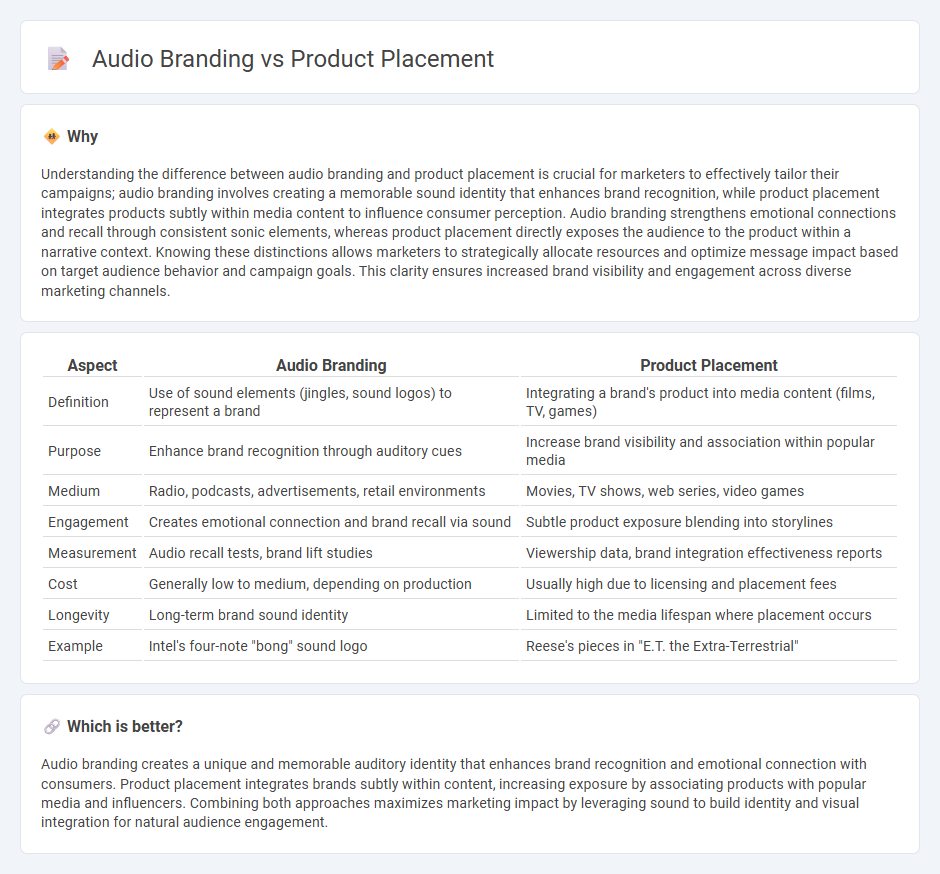
Audio branding enhances brand recognition through unique sound elements like jingles and sonic logos, creating memorable auditory experiences for consumers. Product placement integrates branded products seamlessly into media content, boosting visibility by associating items with popular characters and storylines. Explore how these strategies transform brand engagement and influence consumer behavior.
Why it is important
Understanding the difference between audio branding and product placement is crucial for marketers to effectively tailor their campaigns; audio branding involves creating a memorable sound identity that enhances brand recognition, while product placement integrates products subtly within media content to influence consumer perception. Audio branding strengthens emotional connections and recall through consistent sonic elements, whereas product placement directly exposes the audience to the product within a narrative context. Knowing these distinctions allows marketers to strategically allocate resources and optimize message impact based on target audience behavior and campaign goals. This clarity ensures increased brand visibility and engagement across diverse marketing channels.
Comparison Table
| Aspect | Audio Branding | Product Placement |
|---|---|---|
| Definition | Use of sound elements (jingles, sound logos) to represent a brand | Integrating a brand's product into media content (films, TV, games) |
| Purpose | Enhance brand recognition through auditory cues | Increase brand visibility and association within popular media |
| Medium | Radio, podcasts, advertisements, retail environments | Movies, TV shows, web series, video games |
| Engagement | Creates emotional connection and brand recall via sound | Subtle product exposure blending into storylines |
| Measurement | Audio recall tests, brand lift studies | Viewership data, brand integration effectiveness reports |
| Cost | Generally low to medium, depending on production | Usually high due to licensing and placement fees |
| Longevity | Long-term brand sound identity | Limited to the media lifespan where placement occurs |
| Example | Intel's four-note "bong" sound logo | Reese's pieces in "E.T. the Extra-Terrestrial" |
Which is better?
Audio branding creates a unique and memorable auditory identity that enhances brand recognition and emotional connection with consumers. Product placement integrates brands subtly within content, increasing exposure by associating products with popular media and influencers. Combining both approaches maximizes marketing impact by leveraging sound to build identity and visual integration for natural audience engagement.
Connection
Audio branding enhances product placement effectiveness by embedding distinctive sounds or jingles linked to a brand within media content, increasing consumer recall and emotional connection. Strategic synchronization of audio elements with visual product placement creates a cohesive sensory experience that strengthens brand identity and influences purchasing behavior. This synergy leverages multisensory marketing to optimize brand recognition and engagement across diverse platforms.
Key Terms
Integration
Product placement seamlessly integrates branded products into visual media, enhancing brand visibility without interrupting viewer experience. Audio branding uses distinctive sounds, jingles, or music to create an immediate auditory connection with the brand, strengthening recall through consistent sound identity. Explore how combining these strategies amplifies brand integration and drives consumer engagement.
Brand recall
Product placement integrates branded products subtly into visual media, enhancing brand recall through contextual association and repeated exposure. Audio branding leverages unique sound elements like jingles or sonic logos to create auditory cues that trigger memory and emotional connections with the brand. Explore how these strategies uniquely influence brand recall to optimize your marketing efforts.
Sensory marketing
Product placement integrates branded visuals or messages seamlessly within media content, enhancing brand recall through visual stimuli. Audio branding leverages distinctive sounds, jingles, or voice tones to create emotional connections and reinforce brand identity via auditory channels. Explore more about how sensory marketing strategies like these elevate consumer engagement and drive brand loyalty.
Source and External Links
What Is Product Placement? Definition and Examples | Indeed.com - Product placement is an advertising technique that promotes specific brands and products more naturally within media like movies, TV shows, or retail spaces using props, settings, and strategic product positioning to increase consumer awareness and sales.
Product Placement: Examples and Business Benefits (2025) - Shopify - Product placement involves intentional embedding of products into content such as movies or video games, best implemented with transparency, relevance to the storyline, and enhancing the viewer's experience to maximize marketing impact.
Product placement - Wikipedia - Product placement, also called embedded marketing, is a marketing strategy where brands pay to have their products featured within works like films or TV shows, often to counteract DVR skipping of ads and target precise demographics with contextual brand integration.
 dowidth.com
dowidth.com